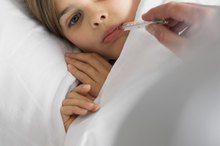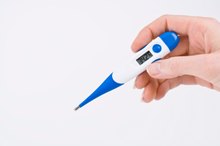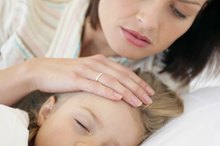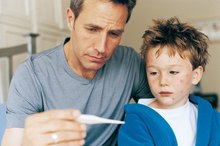Rashes Following a Fever in Children
If your child’s illness has passed and then a rash appears, this can be cause for concern among most parents. Roseola and fifth disease are common childhood illnesses that first cause a fever that’s followed by a rash 2. Always consult with your child’s doctor for a proper diagnosis and treatment.
Identification
Roseola causes a high fever with a quick onset that’s often more than 103 degrees Fahrenheit. Your child will have a runny nose, mild sore throat and red puffy eyes. The fever disappears and then a non-itchy rash of small pink spots develops on your child’s chest, stomach and back before spreading to the extremities. Your child may also have swollen lymph nodes of the neck. Fifth disease has a mild fever with cold-like symptoms that include a runny nose, congestion and cough 2. Once the fever disappears, a rash develops on your child’s face that looks like he was slapped on the cheeks. The rash spreads to your child’s trunk and extremities a few days later. If your child has fifth disease, he does not usually feel ill once the rash is present 2.
- Roseola causes a high fever with a quick onset that’s often more than 103 degrees Fahrenheit.
- The fever disappears and then a non-itchy rash of small pink spots develops on your child’s chest, stomach and back before spreading to the extremities.
Cause
An Infant's Rash on the Feet
Learn More
Roseola is most commonly caused by the human herpesvirus 6, but is sometimes caused by human herpesvirus 7. Fifth disease is caused by parvovirus B16 2. Fifth disease and roseola are contagious and are transmitted by an infected person’s respiratory secretions or saliva, but the illnesses can also be spread by fecal-to-oral transmission 2. These illnesses are easily spread in daycare settings because of frequent diaper changing and because children are less likely to cover a sneeze or wash their hands after using the bathroom. Once the rash is present for both roseola and fifth disease, the illnesses are less contagious 2.
Treatment
Since both are viruses, there is little that can be done to treat the conditions other than making your child comfortable. The high fever from roseola is reduced with acetaminophen or ibuprofen. Since the fever for fifth disease is fairly low-grade, an over-the-counter fever reducer is rarely necessary unless the fever is bothersome or more than 102 degrees Fahrenheit 2. A cool sponge bath provides relief to a child with a high fever. Doctors often give the anti-viral medication ganciclovir to treat roseola in children with weak immune systems. Most children recover within a week from both roseola and fifth disease 2.
Prevention
How to Diagnose Fifth Disease Vs. Hand, Foot and Mouth Disease
Learn More
There is no vaccination for roseola or fifth disease 2. If your child is sick, keep him home from school or daycare. Encourage your child to wash his hands frequently, especially after using the restroom, playing with other children or before eating. Encourage your child's school to disinfect regularly touched surfaces with diluted bleach to kill viruses.
- There is no vaccination for roseola or fifth disease 2.
- Encourage your child to wash his hands frequently, especially after using the restroom, playing with other children or before eating.
Related Articles
References
- KidsHealth.org: Fifth Disease
- MayoClinic.com: Roseola
- Mullins TB, Krishnamurthy K. Roseola Infantum (Exanthema Subitum, Sixth Disease). In: StatPearls [Internet]. 2019.
- Tesini BL, Epstein LG, Caserta MT. Clinical impact of primary infection with roseoloviruses. Curr Opin Virol. 2014;9:91–96. doi:10.1016/j.coviro.2014.09.013
- Agut H, Bonnafous P, Gautheret-dejean A. Laboratory and clinical aspects of human herpesvirus 6 infections. Clin Microbiol Rev. 2015;28(2):313-35. doi:10.1128/CMR.00122-14
- Parra M, Alcala A, Amoros C, et al. Encephalitis associated with human herpesvirus-7 infection in an immunocompetent adult. Virol J. 2017;14(1):97. doi:10.1186/s12985-017-0764-y
- Mullins TB, Krishnamurthy K. Roseola Infantum (Exanthema Subitum, Sixth Disease). In: StatPearls [Internet]. 2019.
- Leung AK, Hon KL, Leung TN. Febrile seizures: an overview. Drugs Context. 2018;7:212536. doi:10.7573/dic.212536
- Tesini BL, Epstein LG, Caserta MT. Clinical impact of primary infection with roseoloviruses. Curr Opin Virol. 2014;9:91-6. doi:10.1016/j.coviro.2014.09.013
- Mandell, Douglas, and Bennett's Principles and Practice of Infectious Diseases (Eighth Edition).
Writer Bio
Melissa McNamara is a certified personal trainer who holds a Bachelor of Arts in journalism and communication studies from the University of Iowa. She writes for various health and fitness publications while working toward a Bachelor of Science in nursing.









